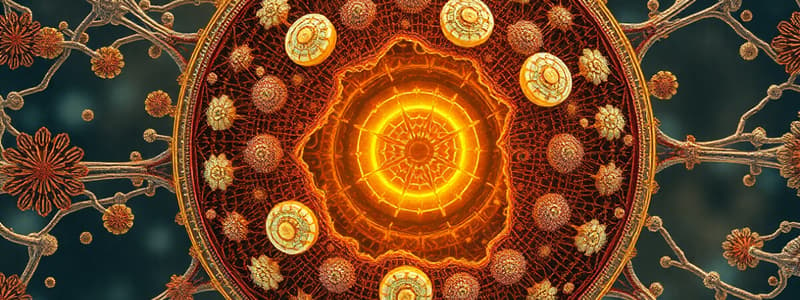Podcast
Questions and Answers
What is the primary function of the nucleolus in eukaryotic cells?
What is the primary function of the nucleolus in eukaryotic cells?
- Lipid synthesis
- Energy production
- Ribosome biogenesis (correct)
- Transcription of DNA
Which statement best describes ribosomes?
Which statement best describes ribosomes?
- They directly synthesize RNA from DNA.
- They produce proteins from amino acids. (correct)
- They store genetic information.
- They are involved in lipid breakdown.
What role does the nucleolus play in the formation of signal recognition particles?
What role does the nucleolus play in the formation of signal recognition particles?
- It synthesizes proteins for cell signaling.
- It participates in ribosome biogenesis. (correct)
- It breaks down faulty ribosomes.
- It houses genetic information.
In which type of cells is the nucleolus most prominent?
In which type of cells is the nucleolus most prominent?
What is a characteristic feature of ribosomes during their function?
What is a characteristic feature of ribosomes during their function?
What is the main function of the nucleus in eukaryotic cells?
What is the main function of the nucleus in eukaryotic cells?
Which characteristic is true of eukaryotic cells?
Which characteristic is true of eukaryotic cells?
Who was likely the first to observe the nucleus and in which type of cells?
Who was likely the first to observe the nucleus and in which type of cells?
What process does the endoplasmic reticulum primarily assist with?
What process does the endoplasmic reticulum primarily assist with?
What defines a eukaryote?
What defines a eukaryote?
Who was the first to use the term 'nuclei' when observing these structures in plant cells?
Who was the first to use the term 'nuclei' when observing these structures in plant cells?
What is the primary role of ribosomes within a cell?
What is the primary role of ribosomes within a cell?
What is the primary role of the nuclear envelope?
What is the primary role of the nuclear envelope?
What structural components make up the nuclear envelope?
What structural components make up the nuclear envelope?
Which of the following describes DNA packaging in cells?
Which of the following describes DNA packaging in cells?
Through which molecular process does the information in DNA get converted into proteins?
Through which molecular process does the information in DNA get converted into proteins?
Which type of proteins provide structural support to the nuclear envelope?
Which type of proteins provide structural support to the nuclear envelope?
What does DNA primarily carry in living organisms?
What does DNA primarily carry in living organisms?
What scientific role did Felice Fontana play in the study of the nucleus?
What scientific role did Felice Fontana play in the study of the nucleus?
Which characteristic is essential for the structure of DNA?
Which characteristic is essential for the structure of DNA?
What type of filaments supports the nuclear membrane's structure?
What type of filaments supports the nuclear membrane's structure?
What is the primary function of chromatin in eukaryotic cells?
What is the primary function of chromatin in eukaryotic cells?
What characterizes the outer membrane of the nuclear envelope?
What characterizes the outer membrane of the nuclear envelope?
What is located within the perinuclear space?
What is located within the perinuclear space?
What do the proteins found on the inner membrane of the nuclear envelope primarily do?
What do the proteins found on the inner membrane of the nuclear envelope primarily do?
Which statement about the nuclear pore complexes is true?
Which statement about the nuclear pore complexes is true?
What is the primary function of the nuclear lamina?
What is the primary function of the nuclear lamina?
How does the nuclear envelope contribute to gene expression regulation?
How does the nuclear envelope contribute to gene expression regulation?
Which statement correctly describes the role of RNA?
Which statement correctly describes the role of RNA?
In which of the following scenarios does gene expression regulation occur?
In which of the following scenarios does gene expression regulation occur?
What unique characteristic do red blood cells have regarding their nucleus?
What unique characteristic do red blood cells have regarding their nucleus?
What is selectively transported from the nucleus to the cytoplasm?
What is selectively transported from the nucleus to the cytoplasm?
What is the significance of posttranscriptional processing of mRNA?
What is the significance of posttranscriptional processing of mRNA?
What is a key feature of the outer membrane of the nuclear envelope?
What is a key feature of the outer membrane of the nuclear envelope?
What happens to the nuclear envelope during mitosis?
What happens to the nuclear envelope during mitosis?
What is the role of NPC proteins during reassembly of the nuclear envelope?
What is the role of NPC proteins during reassembly of the nuclear envelope?
How many proteins make up a nuclear pore complex (NPC)?
How many proteins make up a nuclear pore complex (NPC)?
What symmetry do nuclear pore complexes exhibit?
What symmetry do nuclear pore complexes exhibit?
In which cellular structure do nuclear envelope membrane proteins disperse?
In which cellular structure do nuclear envelope membrane proteins disperse?
Where does the nuclear envelope reassemble during mitosis?
Where does the nuclear envelope reassemble during mitosis?
Which part of the nuclear pore complex has symmetrical arrangement?
Which part of the nuclear pore complex has symmetrical arrangement?
What does the structure of the nuclear pore complex allow regarding transport?
What does the structure of the nuclear pore complex allow regarding transport?
Flashcards
What is the nucleus?
What is the nucleus?
The control center of eukaryotic cells containing DNA.
What is a eukaryote?
What is a eukaryote?
An organism whose cells have a membrane-bound nucleus. Examples include animals, plants, fungi, and some unicellular organisms.
What is DNA packaging?
What is DNA packaging?
The process of packaging DNA into a more compact form within the nucleus.
What is chromatin?
What is chromatin?
Signup and view all the flashcards
What are ribosomes?
What are ribosomes?
Signup and view all the flashcards
What is protein synthesis?
What is protein synthesis?
Signup and view all the flashcards
What is the Endoplasmic Reticulum (ER)?
What is the Endoplasmic Reticulum (ER)?
Signup and view all the flashcards
What is Rough ER?
What is Rough ER?
Signup and view all the flashcards
What is DNA?
What is DNA?
Signup and view all the flashcards
What is the nuclear envelope?
What is the nuclear envelope?
Signup and view all the flashcards
What are nuclear lamins?
What are nuclear lamins?
Signup and view all the flashcards
Who discovered the nucleus?
Who discovered the nucleus?
Signup and view all the flashcards
Who was the first to call these structures 'nuclei'?
Who was the first to call these structures 'nuclei'?
Signup and view all the flashcards
What is the role of DNA in the nucleus?
What is the role of DNA in the nucleus?
Signup and view all the flashcards
What is the main function of the nucleus?
What is the main function of the nucleus?
Signup and view all the flashcards
Nucleolus
Nucleolus
Signup and view all the flashcards
Ribosomes
Ribosomes
Signup and view all the flashcards
Nuclear Lamins
Nuclear Lamins
Signup and view all the flashcards
Nucleolar Organizing Region
Nucleolar Organizing Region
Signup and view all the flashcards
Nuclear Envelope
Nuclear Envelope
Signup and view all the flashcards
Nuclear Pores
Nuclear Pores
Signup and view all the flashcards
Transcription
Transcription
Signup and view all the flashcards
Translation
Translation
Signup and view all the flashcards
RNA Processing
RNA Processing
Signup and view all the flashcards
Transcriptional Regulation
Transcriptional Regulation
Signup and view all the flashcards
Transcription Factors
Transcription Factors
Signup and view all the flashcards
Inner Nuclear Membrane
Inner Nuclear Membrane
Signup and view all the flashcards
Perinuclear Space
Perinuclear Space
Signup and view all the flashcards
What happens to the nuclear envelope during mitosis?
What happens to the nuclear envelope during mitosis?
Signup and view all the flashcards
Where do the nuclear envelope membrane proteins go during mitosis?
Where do the nuclear envelope membrane proteins go during mitosis?
Signup and view all the flashcards
How and where does the nuclear envelope reassemble after mitosis?
How and where does the nuclear envelope reassemble after mitosis?
Signup and view all the flashcards
What are nuclear pore complexes (NPCs) made of?
What are nuclear pore complexes (NPCs) made of?
Signup and view all the flashcards
How are the proteins within the NPC oriented?
How are the proteins within the NPC oriented?
Signup and view all the flashcards
What is the primary function of the nuclear pore complex (NPC)?
What is the primary function of the nuclear pore complex (NPC)?
Signup and view all the flashcards
What makes the nuclear pore complex selective?
What makes the nuclear pore complex selective?
Signup and view all the flashcards
How does the nuclear envelope relate to the endoplasmic reticulum?
How does the nuclear envelope relate to the endoplasmic reticulum?
Signup and view all the flashcards
Study Notes
Cell Biology - Nucleus
- The nucleus is the control center of eukaryotic cells
- It stores the cell's DNA, which contains the instructions for building and running the cell
- The nucleus is a membranous organelle
- It contains a double membrane called the nuclear envelope
- The nuclear envelope separates the nucleus from the cytoplasm
- The nuclear envelope has pores to allow the transport of molecules between the nucleus and the cytoplasm
- The nuclear envelope is supported by a meshwork of intermediate filaments called nuclear lamins which provide structural support and regulate transcription
- DNA is packaged into chromosomes inside the nucleus
Nucleolus
- Found inside the nucleus
- Involved in ribosome biogenesis (ribosome production)
Key facts on the Nucleus
- Contains DNA arranged in chromosomes
- Surrounded by a double nuclear membrane
- Separates the nucleus from the cytoplasm
- Supported by intermediate filaments
- DNA exists as chromatin
Nuclear Pores & Nuclear Pore Complex
- ~30 proteins, which form a roughly eight-fold rotational symmetry
- The nuclear envelope contains pores to allow transport
- Small molecules like water, amino acids, and nucleotides can pass through freely
- Larger molecules like proteins require specific signals
- Proteins have Nuclear Localization Signals (NLSs) that get recognised by receptor proteins, initiating the process for larger proteins to enter the nucleus
Nuclear Import Receptors
- Karyopherins (e.g., importins) bind proteins with NLS and transport them into the nucleus.
- Import receptors bind to FG repeats found on nucleoporins
- Disrupt interactions between repeats to allow diffusion
- Receptor-cargo complexes pass into the nucleus
Nuclear Export
- Export through NPCs relies on export signals
- Related to Import in terms of mechanisms, although the directions are in the opposite direction to the nucleus
Ran GTPase
- An essential GTPase that powers nuclear transport
- Plays a role in import and export mechanisms
- Has different forms in the cytosol and nucleus affecting the directionality of transport
Nuclear Lamina
- A network of fibrous proteins located on the inner side of the nuclear membrane
- Provides structural support and stability
- Anchored to NPCs, integral membrane proteins, and directly to chromatin
Summary of Nuclear Transport
- The nuclear envelope regulates transport of molecules into and out of the nucleus
- Specific signals (NLSs, NESs) target proteins for import/export
- Protein transport is facilitated by carrier molecules
- The molecular mechanisms of transport for import & export are similar, only in opposite direction.
- Ran GTPase regulates directionality of the transport
Learning Outcomes
- Identify features of the nucleus
- Describe structures of the Endoplasmic Reticulum and Ribosomes
- Describe how DNA is packaged
- Describe how proteins are synthesized
Studying That Suits You
Use AI to generate personalized quizzes and flashcards to suit your learning preferences.




